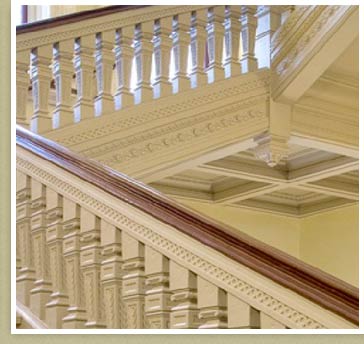A Masterpiece of Design & Construction

Alfred B. Mullett designed this building in 1872, inspired by the grand architecture of Napoleon lll’s modernization of Paris in the mid-1800s. As Supervising Architect of the U.S. Treasury, Mullett designed six monumental buildings in this style, but only this and one other remain standing — the Old Executive Office Building in Washington, D.C.
While excavating for the building’s foundation in 1872, quicksand was discovered. Quick thinking produced a sound solution: 4,400 pilings of pine were forced into the mire, followed by hundreds of bales of cotton. Next came a four-foot-thick slab of concrete, forming a foundation so solid that even now, more than a century later, no settlement cracking is found!
This building’s design incorporated innovative systems for heating and ventilation, and made brilliant use of natural light. Designed just after the devastating Chicago fire of 1871, fireproof construction was of utmost importance. The entire framework of the building and dome, as well as stairwells, doorjambs and window frames were all rendered in cast iron. In addition to offering state-of-the-art fire protection, cast iron allowed for exquisite decorative detailing to be achieved affordably, where hand-carving would have been prohibitive.
A moat surrounds the building — 8.5’ wide and 28.5’ deep — allowing light and ventilation to reach two levels of basement. Thick, sliding steel shutters hidden in the walls next to each window offered protection from any possible threat of fire from adjacent, less fire-proof buildings.
Other interior features of note include ornamental plaster cornices and medallions, art glass windows, bronze doorknobs displaying the Seal of the United States, cast-iron ventilation grilles, red Italian Bologna marble mantels and wall-to-wall tapestries of encaustic tile adorning the third and fourth floors and two grand stairwells. With the color running all the way through, the tiles have worn in, (as opposed to wearing out!) and are as beautiful today as ever.
Adorning the building is Daniel Chester French’s sculpture, Peace and Vigilance. Commissioned early in his career, it is less famous, but no less beautiful than his later work, which includes the massive seated portrait of Abraham Lincoln at the Lincoln Memorial in Washington, D.C. Installed in 1882 on this building’s iconic dome, Peace and Vigilance suffered through more than 100 years of exposure and erosion, before being replaced on the dome by a cement replica in 1990. Masterfully restored, the original was then safely reinstalled in the building’s light-filled central atrium for all to enjoy.


